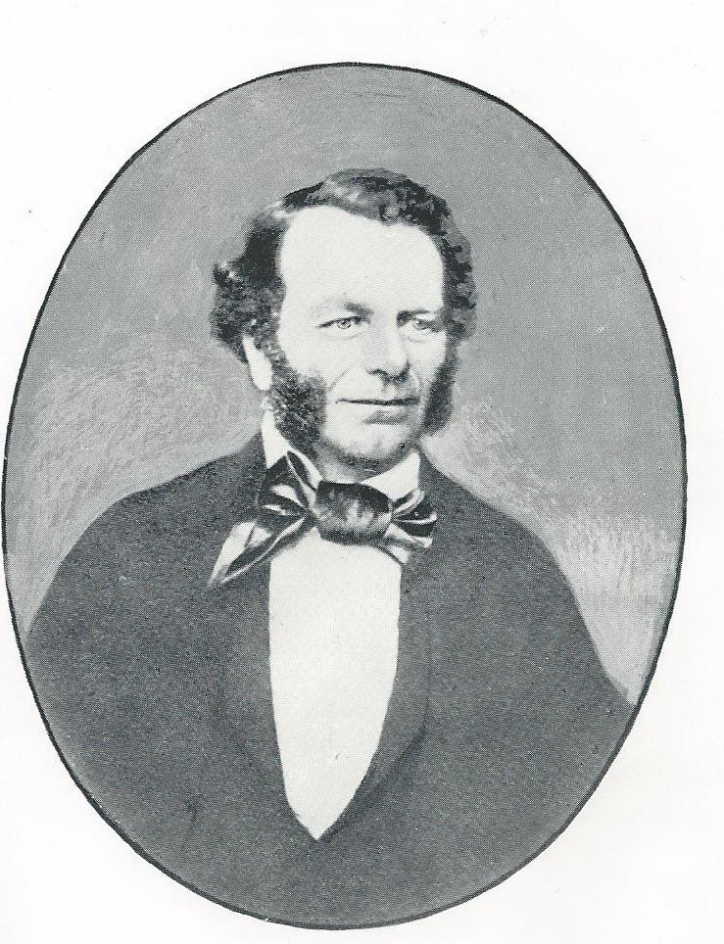George RHODES [31615]
- Born: 14 Jul 1816, Epworth LIN
- Baptised: 16 Sep 1816, Epworth LIN
- Marriage (1): Elizabeth WOOD [31618] on 31 May 1854
- Died: 18 Jun 1864, Purau Lyttleton Canterbury NZ aged 47
 Cause of his death was typhoid. Cause of his death was typhoid.

 General Notes: General Notes:
George Rhodes is said to have been born on 14 July 1816, and was baptised on 16 September 1816 at Epworth, Lincolnshire, England. He was the seventh child and fourth son of William Rhodes and his wife, Theodosia Maria Heaton. George's father was a tenant farmer successively at Epworth, and the Plains House in the Levels district, between the southern tributaries of the Humber in Yorkshire. His mother's family, long eminent in the towns of Yorkshire and Lincolnshire, encouraged and financed the seafaring enterprises of William Barnard Rhodes, his eldest brother.
William was joined in his Australian-based Pacific trading ventures and his New Zealand land interests by George and three other brothers. The main activities of Robert Heaton Rhodes had been in Australia until he came to New Zealand in 1850. Joseph Rhodes reached New Zealand early in 1843, stayed but a short while on Banks Peninsula, and afterwards lived a successful life in the North Island, independent of his brothers' South Island partnerships. Peter Barnard Rhodes, who came out to New Zealand with George, soon returned to England.
George himself arrived in 1843, and was appointed by William to take charge of land adjacent to the Banks Peninsula whaling stations. It had originally been bought or leased from the Maori owners by William, his Australian partners, or their agents; or obtained by odd transactions such as Captain George Hempleman's assignment of property as security for a debt of £40 16s. 10d. More land was added after George's arrival, including, in 1847, the Maori lease of Purau.
Most of these acquisitions pre-dated the definition of the Canterbury block. Consequently George and William, besides managing the stock, which had been shipped from Australia, had to struggle to obtain valid Crown titles for as much land as they could retain. During 1849 the Rhodes brothers were granted a form of 'squatter's licence' to graze unoccupied land, and the following year Robert Heaton Rhodes crossed from Australia and took over Purau. With astute judgement the brothers applied to the New Zealand government for the right to settle in South Canterbury, beyond the southern boundary of the Canterbury block.
The choice of South Canterbury by the Rhodes brothers was not based on guesswork. Before the construction of roads and railways, most communication was by sea, and sailors spread news. Travellers of the 1840s also recorded much information, including reports from the Maori people about inland routes and lakes. The brothers Joseph, Edward and George Weller had worked whaling stations on the shores of the future Timaru in 1839 and 1840, and had claimed vast inland areas. Another whaler, Sam Williams, is said to have taken George, and possibly Robert, to explore South Canterbury in 1850.
In 1851 George and Robert, helped by several men, drove 5,000 sheep from Banks Peninsula to the uninhabited Timaru area. They claimed over 150,000 acres of land and George established a sheep station, which was named the Levels after the Yorkshire district in which the Rhodes family farmed. The lesson was quickly learned by observers that pasturage was better value outside than inside the Canterbury block.
At first George managed the Levels from near Timaru's pre-breakwater landing place, and there he brought his bride, Elizabeth Wood, whom he had married on 31 May 1854 at Lyttelton. The couple then moved out to the Levels, where they built a house and raised a family of five sons and a daughter.
In 1855 some sheep were stolen from the Levels station, by James Mackenzie. With great determination George directed the pursuit, capture and prosecution of the thief. He reacted no less firmly when his neighbour was slack about tallies and marking. Yet, while he was exacting and somewhat mercenary in business matters, his letters to friends and family reveal an affectionate nature.
George Rhodes and his brothers profited from the growth of Timaru by selling their sections of land in the town centre. They also contributed to community life: St Mary's Church (Anglican) at Timaru was built between 1860 and 1861 on land given by them, and George was one of the first wardens. George was also a justice of the peace and a member of local committees and institutions.
George's life was productive but brief. He died of typhoid fever at Purau on 18 June 1864. In Timaru, street names such as George Street and Elizabeth Street honour the Rhodes family still.

George married Elizabeth WOOD [31618] [MRIN: 11220] on 31 May 1854. (Elizabeth WOOD [31618] was born in 1835 in Lyttleton Canterbury NZ and died on 10 Jul 1890 in Timaru NZ.)
|

